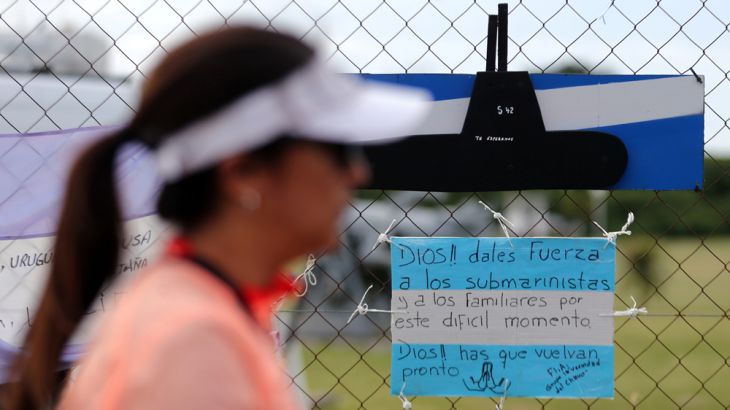‘Blast’ heard hours after Argentinian sub went missing
Missing for eight days, concern for the 44 sailors grows as oxygen supplies are nearly depleted.

A sound detected by sensors hours after an Argentine submarine sent its last signal was “consistent with an explosion”, a navy spokesman said on Thursday.
A search operation has been under way since contact with the submarine – with 44 sailors on board – ceased on the morning of November 15.
Concern for the crew has increased as oxygen supplies are running low. Experts say the ARA San Juan had enough oxygen to last seven to 10 days.
“Some information was received regarding the singular anomalous event – short, violent, and non nuclear – consistent with that of an explosion,” said navy spokesman Enrique Balbi.
The San Juan went missing in the South Atlantic off the coast of Argentina. Balbi said there was no sign the blast might be linked to an attack on the sub.
US Navy Lieutenant Lily Hinz said the unusual sound detected underwater could not be attributed to marine life or naturally occurring noise in the ocean.
“It was not a whale and it is not a regularly occurring sound,” Hinz said.
The submarine’s disappearance prompted a massive search for the vessel, involving 10 countries.
“It’s not looking good. The fate of those 44 crew members on ARA San Juan is looking increasingly grim,” Al Jazeera correspondent Daniel Schweimler said from Buenos Aires.
Family members are angry with the Argentinian authorities, saying it has taken the navy too long for this information to come to light. “Many of them are fearing the worst, many of them fear they are dead,” Schweimler added.
Since the start of the operation, about 480,000-square kilometres have been combed. Initially, the multinational effort was impeded by bad weather conditions that caused waves of more than six metres in height.
The San Juan is a TR-1700-class, non-nuclear submarine, built in the former West Germany. It officially entered service in 1985 and was refurbished to modern standards in 2013.